Systems Theory Application in Amsterdam Nursing Home: A Report
VerifiedAdded on 2019/10/30
|6
|1276
|237
Report
AI Summary
This report analyzes the application of systems theory to address the nursing staff shortage at Amsterdam Nursing Home. The study uses the systems theory framework, which views organizations as open systems with inputs, throughputs, outputs, cycles, and feedback mechanisms. The shortage of nurses is a significant problem, and the report identifies the inputs (nursing staff, patients, supplies), throughput (patient processes), and outputs (patient benefits). Due to staff shortages, the hospital experiences delays and reduced output. The report proposes strategies to increase nursing efficiency, including reducing patient waiting times, implementing an online booking system, providing yearly nurse training, rotating nurses between stations, and fostering collaboration between nurses and other healthcare professionals. The goal is to balance nursing care with the patient ratio, reduce workload, and improve patient outcomes, ultimately adapting the organization to challenges through system changes. The report concludes that the application of systems theory can significantly enhance nursing efficiency and patient satisfaction despite staff shortages.
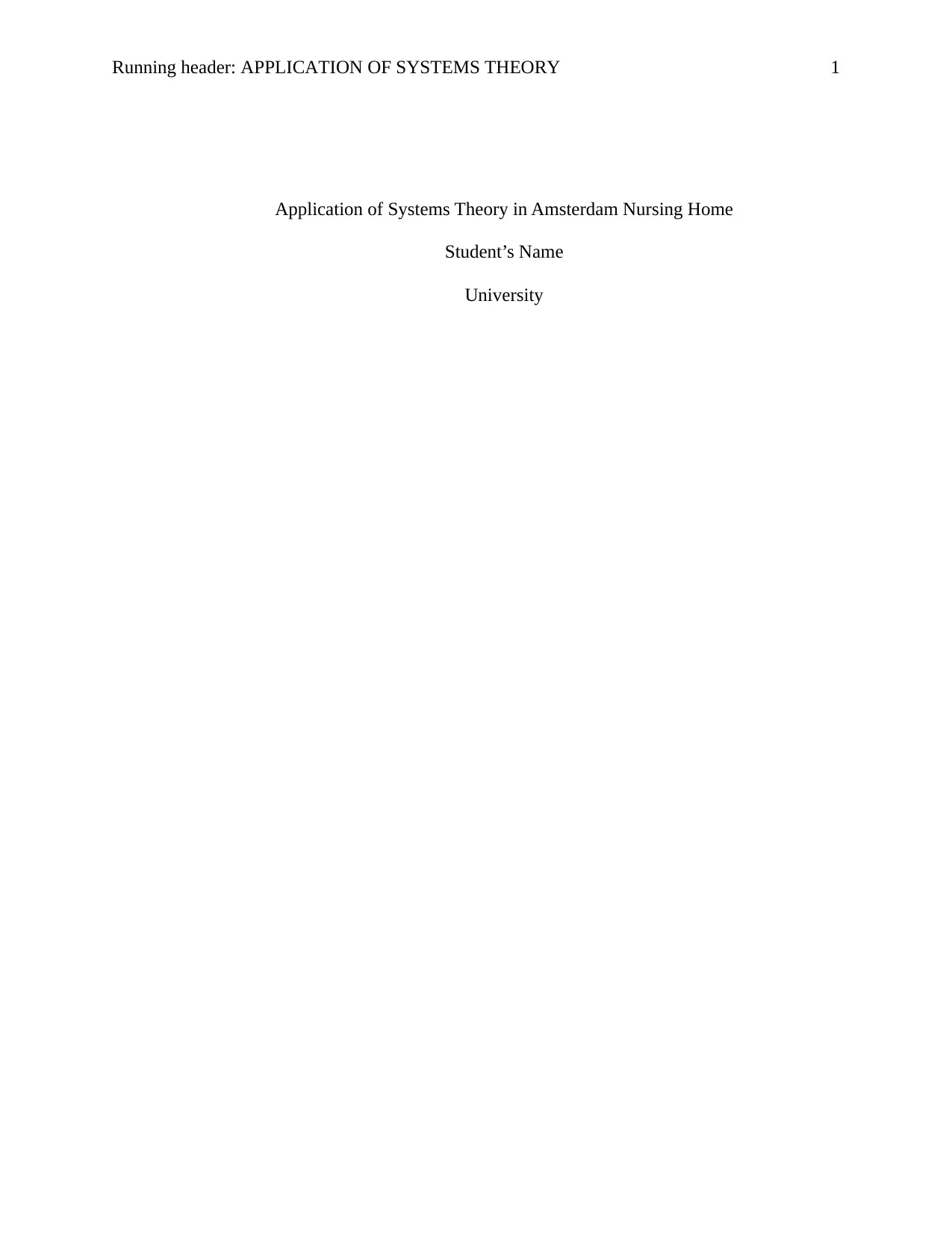
Running header: APPLICATION OF SYSTEMS THEORY 1
Application of Systems Theory in Amsterdam Nursing Home
Student’s Name
University
Application of Systems Theory in Amsterdam Nursing Home
Student’s Name
University
Paraphrase This Document
Need a fresh take? Get an instant paraphrase of this document with our AI Paraphraser
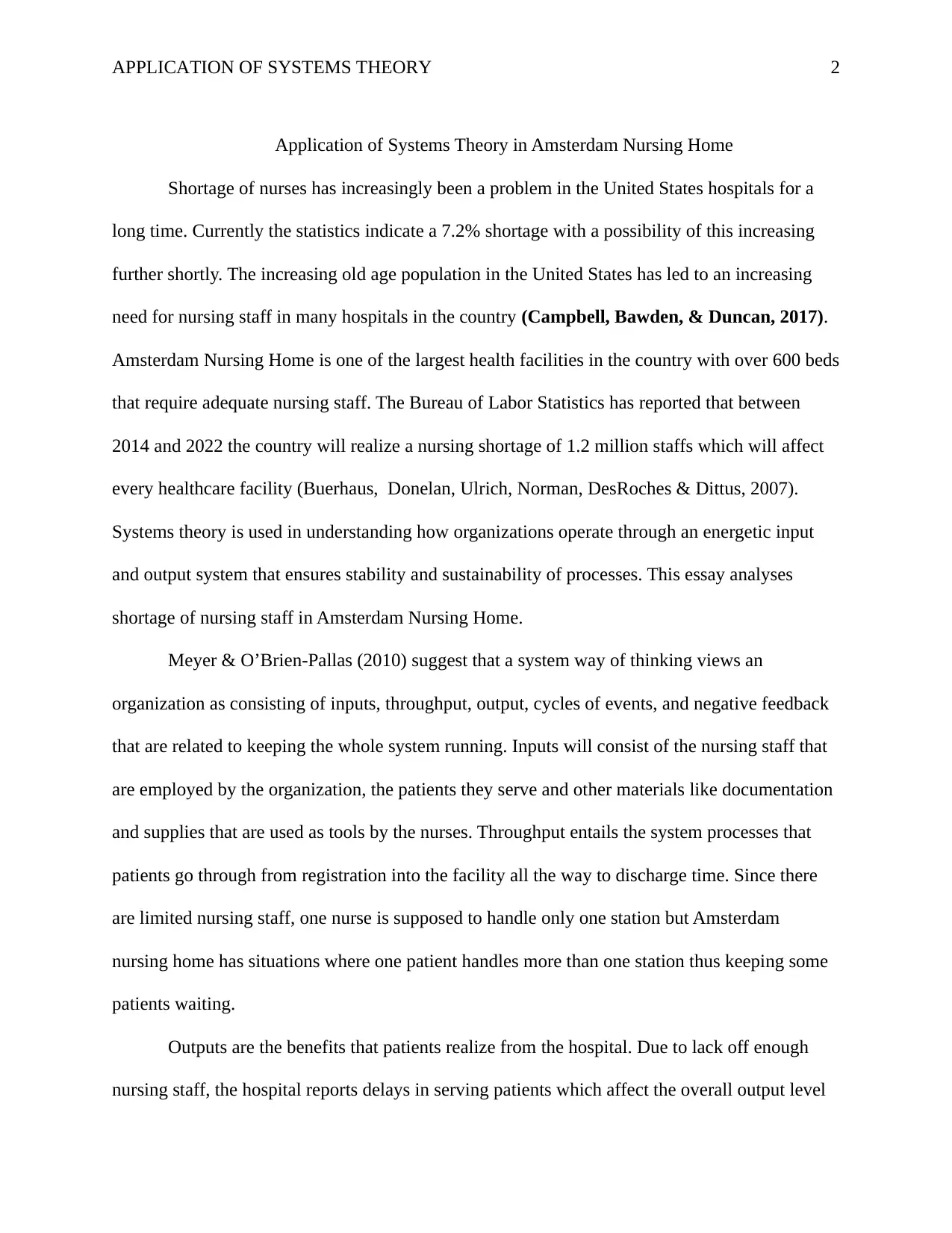
APPLICATION OF SYSTEMS THEORY 2
Application of Systems Theory in Amsterdam Nursing Home
Shortage of nurses has increasingly been a problem in the United States hospitals for a
long time. Currently the statistics indicate a 7.2% shortage with a possibility of this increasing
further shortly. The increasing old age population in the United States has led to an increasing
need for nursing staff in many hospitals in the country (Campbell, Bawden, & Duncan, 2017).
Amsterdam Nursing Home is one of the largest health facilities in the country with over 600 beds
that require adequate nursing staff. The Bureau of Labor Statistics has reported that between
2014 and 2022 the country will realize a nursing shortage of 1.2 million staffs which will affect
every healthcare facility (Buerhaus, Donelan, Ulrich, Norman, DesRoches & Dittus, 2007).
Systems theory is used in understanding how organizations operate through an energetic input
and output system that ensures stability and sustainability of processes. This essay analyses
shortage of nursing staff in Amsterdam Nursing Home.
Meyer & O’Brien-Pallas (2010) suggest that a system way of thinking views an
organization as consisting of inputs, throughput, output, cycles of events, and negative feedback
that are related to keeping the whole system running. Inputs will consist of the nursing staff that
are employed by the organization, the patients they serve and other materials like documentation
and supplies that are used as tools by the nurses. Throughput entails the system processes that
patients go through from registration into the facility all the way to discharge time. Since there
are limited nursing staff, one nurse is supposed to handle only one station but Amsterdam
nursing home has situations where one patient handles more than one station thus keeping some
patients waiting.
Outputs are the benefits that patients realize from the hospital. Due to lack off enough
nursing staff, the hospital reports delays in serving patients which affect the overall output level
Application of Systems Theory in Amsterdam Nursing Home
Shortage of nurses has increasingly been a problem in the United States hospitals for a
long time. Currently the statistics indicate a 7.2% shortage with a possibility of this increasing
further shortly. The increasing old age population in the United States has led to an increasing
need for nursing staff in many hospitals in the country (Campbell, Bawden, & Duncan, 2017).
Amsterdam Nursing Home is one of the largest health facilities in the country with over 600 beds
that require adequate nursing staff. The Bureau of Labor Statistics has reported that between
2014 and 2022 the country will realize a nursing shortage of 1.2 million staffs which will affect
every healthcare facility (Buerhaus, Donelan, Ulrich, Norman, DesRoches & Dittus, 2007).
Systems theory is used in understanding how organizations operate through an energetic input
and output system that ensures stability and sustainability of processes. This essay analyses
shortage of nursing staff in Amsterdam Nursing Home.
Meyer & O’Brien-Pallas (2010) suggest that a system way of thinking views an
organization as consisting of inputs, throughput, output, cycles of events, and negative feedback
that are related to keeping the whole system running. Inputs will consist of the nursing staff that
are employed by the organization, the patients they serve and other materials like documentation
and supplies that are used as tools by the nurses. Throughput entails the system processes that
patients go through from registration into the facility all the way to discharge time. Since there
are limited nursing staff, one nurse is supposed to handle only one station but Amsterdam
nursing home has situations where one patient handles more than one station thus keeping some
patients waiting.
Outputs are the benefits that patients realize from the hospital. Due to lack off enough
nursing staff, the hospital reports delays in serving patients which affect the overall output level

APPLICATION OF SYSTEMS THEORY 3
of the organization. System as a cycle of events entails sustainability of the system through
repeat the same activities over similar output characteristics or new characteristics (Carter
A.J.E. & Chochinov, 2007). There are standard nursing procedures like collecting patient
information to allocate a physician. Since the processes are standardized, they are repeated
activities that have to be done every time a new case is administered. Negative feedback systems
are used to improve system running through analyzing performance indicators. Amsterdam
Nursing home has a feedback mechanism for analyzing how the organization performs
(Amsterdam Nursing Home, 2017).
Shortage of nurses is one of policy issues affecting the healthcare system in the United
States (Buchan & Aiken, 2010). This means that the hospital has to develop plans to address the
clinical shortage through utilizing the available human resource personnel. Hiring new nurses
may not be the best solution since the country is encountering a nursing shortage. Systems theory
approaches this issue by identifying the organization as an open system with inputs and outputs.
Under normal circumstances, inputs and outputs need to be balanced to achieve stability and
sustainability of the system. This is through a set of outcomes, goals, objectives and professional
standards that can be put in place to address staff shortage without necessarily hiring new ones.
Desired outcomes
a) Reduced patient waiting time.
b) Reduced time spend by patients in every station.
c) Increased collaboration between nurses and other healthcare professions.
d) Patient booking system to reduce waiting time.
Goals
of the organization. System as a cycle of events entails sustainability of the system through
repeat the same activities over similar output characteristics or new characteristics (Carter
A.J.E. & Chochinov, 2007). There are standard nursing procedures like collecting patient
information to allocate a physician. Since the processes are standardized, they are repeated
activities that have to be done every time a new case is administered. Negative feedback systems
are used to improve system running through analyzing performance indicators. Amsterdam
Nursing home has a feedback mechanism for analyzing how the organization performs
(Amsterdam Nursing Home, 2017).
Shortage of nurses is one of policy issues affecting the healthcare system in the United
States (Buchan & Aiken, 2010). This means that the hospital has to develop plans to address the
clinical shortage through utilizing the available human resource personnel. Hiring new nurses
may not be the best solution since the country is encountering a nursing shortage. Systems theory
approaches this issue by identifying the organization as an open system with inputs and outputs.
Under normal circumstances, inputs and outputs need to be balanced to achieve stability and
sustainability of the system. This is through a set of outcomes, goals, objectives and professional
standards that can be put in place to address staff shortage without necessarily hiring new ones.
Desired outcomes
a) Reduced patient waiting time.
b) Reduced time spend by patients in every station.
c) Increased collaboration between nurses and other healthcare professions.
d) Patient booking system to reduce waiting time.
Goals
⊘ This is a preview!⊘
Do you want full access?
Subscribe today to unlock all pages.

Trusted by 1+ million students worldwide
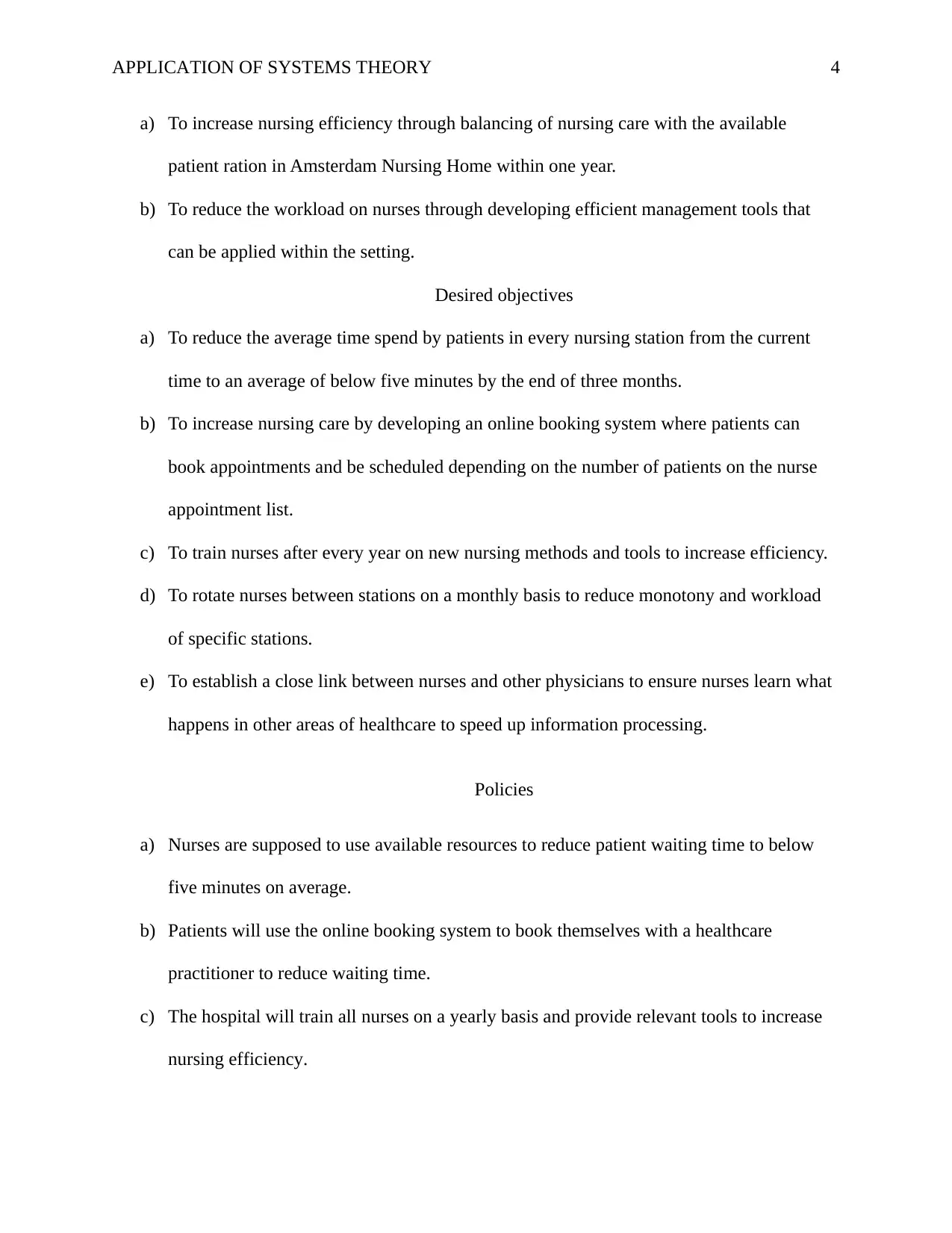
APPLICATION OF SYSTEMS THEORY 4
a) To increase nursing efficiency through balancing of nursing care with the available
patient ration in Amsterdam Nursing Home within one year.
b) To reduce the workload on nurses through developing efficient management tools that
can be applied within the setting.
Desired objectives
a) To reduce the average time spend by patients in every nursing station from the current
time to an average of below five minutes by the end of three months.
b) To increase nursing care by developing an online booking system where patients can
book appointments and be scheduled depending on the number of patients on the nurse
appointment list.
c) To train nurses after every year on new nursing methods and tools to increase efficiency.
d) To rotate nurses between stations on a monthly basis to reduce monotony and workload
of specific stations.
e) To establish a close link between nurses and other physicians to ensure nurses learn what
happens in other areas of healthcare to speed up information processing.
Policies
a) Nurses are supposed to use available resources to reduce patient waiting time to below
five minutes on average.
b) Patients will use the online booking system to book themselves with a healthcare
practitioner to reduce waiting time.
c) The hospital will train all nurses on a yearly basis and provide relevant tools to increase
nursing efficiency.
a) To increase nursing efficiency through balancing of nursing care with the available
patient ration in Amsterdam Nursing Home within one year.
b) To reduce the workload on nurses through developing efficient management tools that
can be applied within the setting.
Desired objectives
a) To reduce the average time spend by patients in every nursing station from the current
time to an average of below five minutes by the end of three months.
b) To increase nursing care by developing an online booking system where patients can
book appointments and be scheduled depending on the number of patients on the nurse
appointment list.
c) To train nurses after every year on new nursing methods and tools to increase efficiency.
d) To rotate nurses between stations on a monthly basis to reduce monotony and workload
of specific stations.
e) To establish a close link between nurses and other physicians to ensure nurses learn what
happens in other areas of healthcare to speed up information processing.
Policies
a) Nurses are supposed to use available resources to reduce patient waiting time to below
five minutes on average.
b) Patients will use the online booking system to book themselves with a healthcare
practitioner to reduce waiting time.
c) The hospital will train all nurses on a yearly basis and provide relevant tools to increase
nursing efficiency.
Paraphrase This Document
Need a fresh take? Get an instant paraphrase of this document with our AI Paraphraser
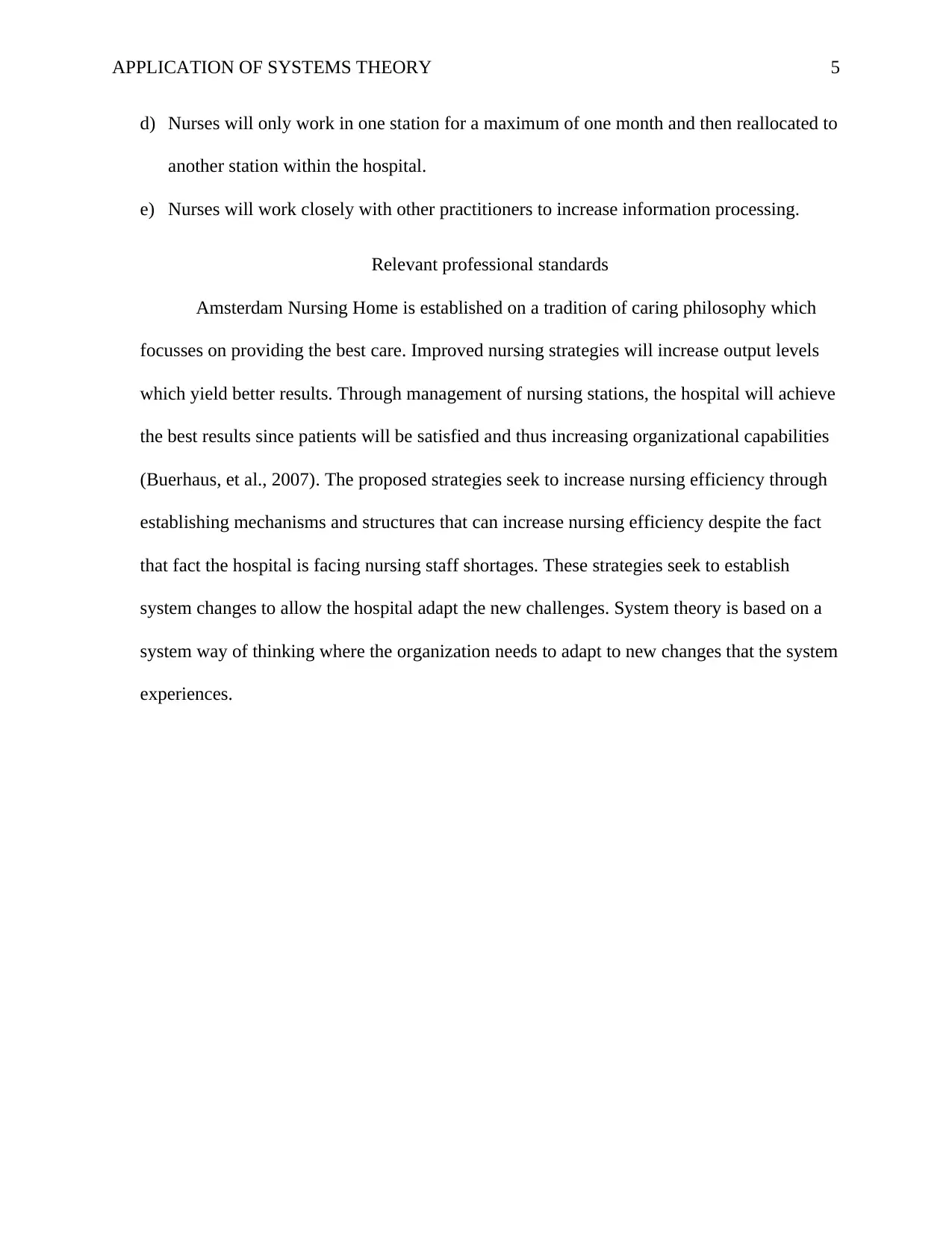
APPLICATION OF SYSTEMS THEORY 5
d) Nurses will only work in one station for a maximum of one month and then reallocated to
another station within the hospital.
e) Nurses will work closely with other practitioners to increase information processing.
Relevant professional standards
Amsterdam Nursing Home is established on a tradition of caring philosophy which
focusses on providing the best care. Improved nursing strategies will increase output levels
which yield better results. Through management of nursing stations, the hospital will achieve
the best results since patients will be satisfied and thus increasing organizational capabilities
(Buerhaus, et al., 2007). The proposed strategies seek to increase nursing efficiency through
establishing mechanisms and structures that can increase nursing efficiency despite the fact
that fact the hospital is facing nursing staff shortages. These strategies seek to establish
system changes to allow the hospital adapt the new challenges. System theory is based on a
system way of thinking where the organization needs to adapt to new changes that the system
experiences.
d) Nurses will only work in one station for a maximum of one month and then reallocated to
another station within the hospital.
e) Nurses will work closely with other practitioners to increase information processing.
Relevant professional standards
Amsterdam Nursing Home is established on a tradition of caring philosophy which
focusses on providing the best care. Improved nursing strategies will increase output levels
which yield better results. Through management of nursing stations, the hospital will achieve
the best results since patients will be satisfied and thus increasing organizational capabilities
(Buerhaus, et al., 2007). The proposed strategies seek to increase nursing efficiency through
establishing mechanisms and structures that can increase nursing efficiency despite the fact
that fact the hospital is facing nursing staff shortages. These strategies seek to establish
system changes to allow the hospital adapt the new challenges. System theory is based on a
system way of thinking where the organization needs to adapt to new changes that the system
experiences.
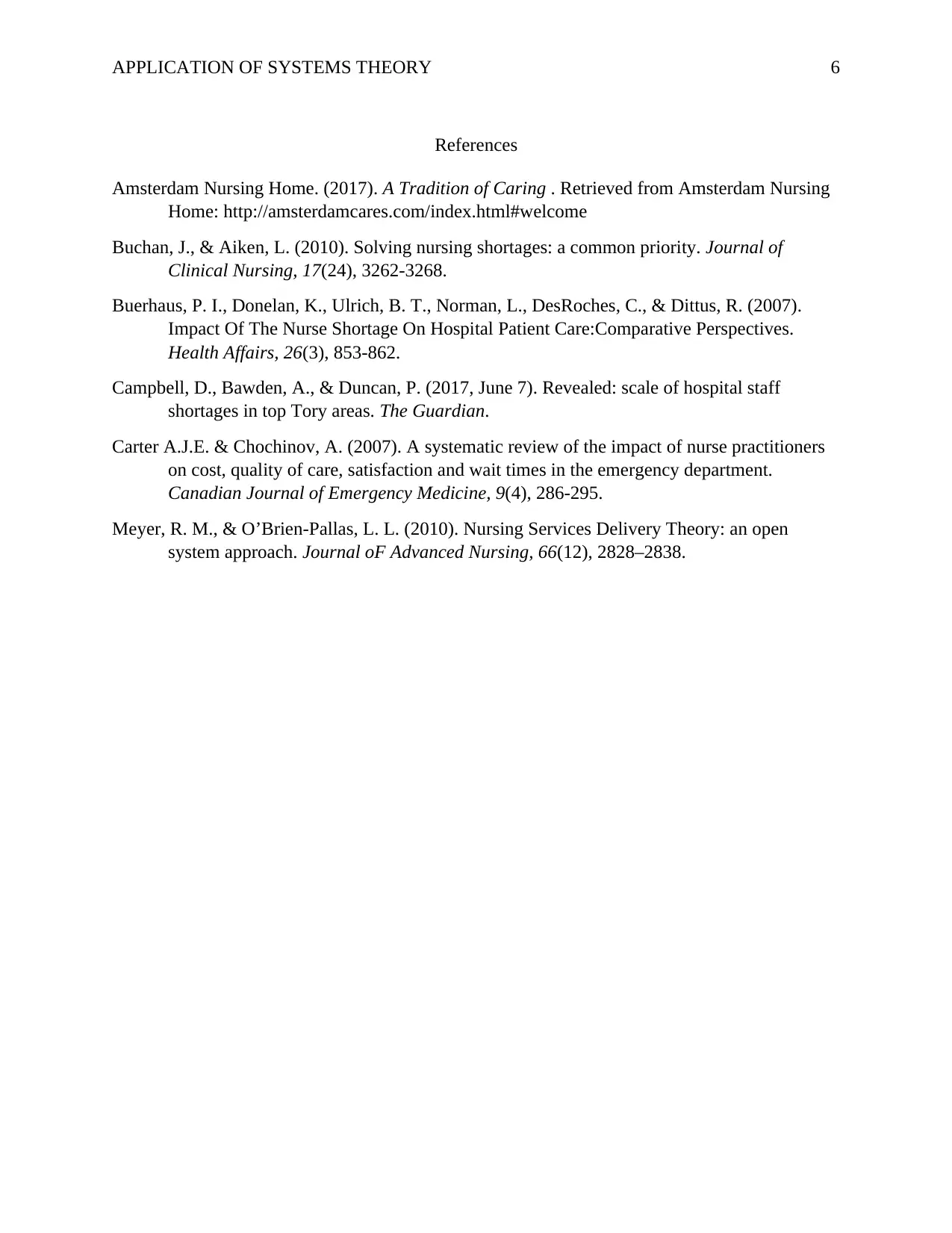
APPLICATION OF SYSTEMS THEORY 6
References
Amsterdam Nursing Home. (2017). A Tradition of Caring . Retrieved from Amsterdam Nursing
Home: http://amsterdamcares.com/index.html#welcome
Buchan, J., & Aiken, L. (2010). Solving nursing shortages: a common priority. Journal of
Clinical Nursing, 17(24), 3262-3268.
Buerhaus, P. I., Donelan, K., Ulrich, B. T., Norman, L., DesRoches, C., & Dittus, R. (2007).
Impact Of The Nurse Shortage On Hospital Patient Care:Comparative Perspectives.
Health Affairs, 26(3), 853-862.
Campbell, D., Bawden, A., & Duncan, P. (2017, June 7). Revealed: scale of hospital staff
shortages in top Tory areas. The Guardian.
Carter A.J.E. & Chochinov, A. (2007). A systematic review of the impact of nurse practitioners
on cost, quality of care, satisfaction and wait times in the emergency department.
Canadian Journal of Emergency Medicine, 9(4), 286-295.
Meyer, R. M., & O’Brien-Pallas, L. L. (2010). Nursing Services Delivery Theory: an open
system approach. Journal oF Advanced Nursing, 66(12), 2828–2838.
References
Amsterdam Nursing Home. (2017). A Tradition of Caring . Retrieved from Amsterdam Nursing
Home: http://amsterdamcares.com/index.html#welcome
Buchan, J., & Aiken, L. (2010). Solving nursing shortages: a common priority. Journal of
Clinical Nursing, 17(24), 3262-3268.
Buerhaus, P. I., Donelan, K., Ulrich, B. T., Norman, L., DesRoches, C., & Dittus, R. (2007).
Impact Of The Nurse Shortage On Hospital Patient Care:Comparative Perspectives.
Health Affairs, 26(3), 853-862.
Campbell, D., Bawden, A., & Duncan, P. (2017, June 7). Revealed: scale of hospital staff
shortages in top Tory areas. The Guardian.
Carter A.J.E. & Chochinov, A. (2007). A systematic review of the impact of nurse practitioners
on cost, quality of care, satisfaction and wait times in the emergency department.
Canadian Journal of Emergency Medicine, 9(4), 286-295.
Meyer, R. M., & O’Brien-Pallas, L. L. (2010). Nursing Services Delivery Theory: an open
system approach. Journal oF Advanced Nursing, 66(12), 2828–2838.
⊘ This is a preview!⊘
Do you want full access?
Subscribe today to unlock all pages.

Trusted by 1+ million students worldwide
1 out of 6
Your All-in-One AI-Powered Toolkit for Academic Success.
+13062052269
info@desklib.com
Available 24*7 on WhatsApp / Email
![[object Object]](/_next/static/media/star-bottom.7253800d.svg)
Unlock your academic potential
Copyright © 2020–2025 A2Z Services. All Rights Reserved. Developed and managed by ZUCOL.

